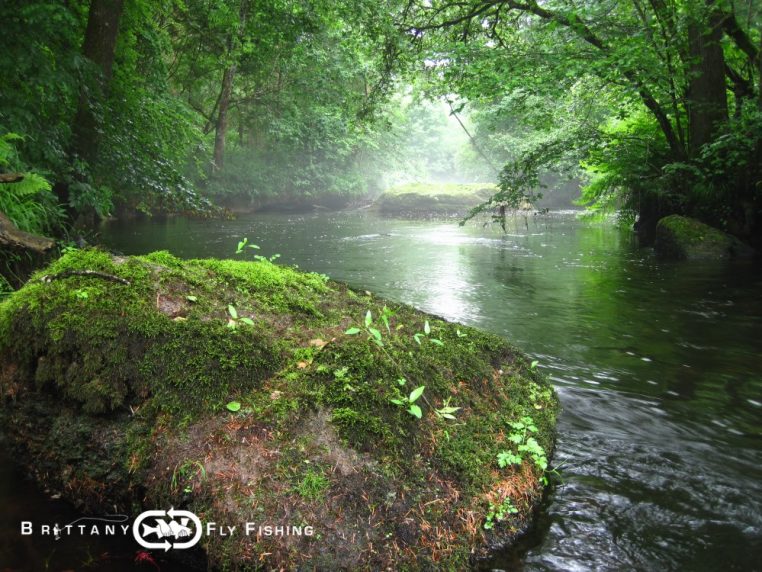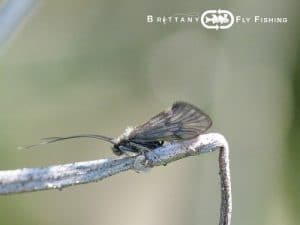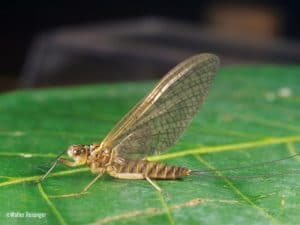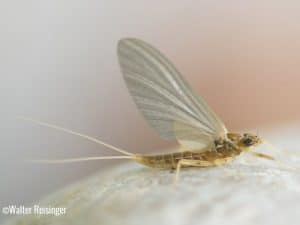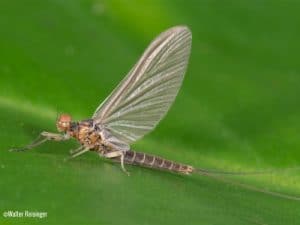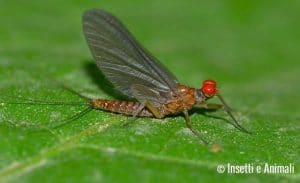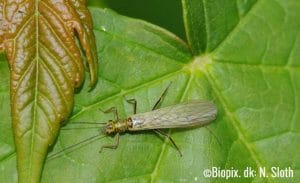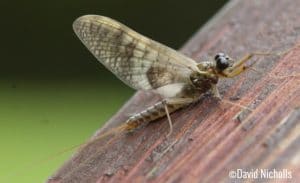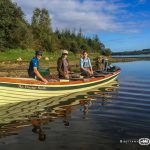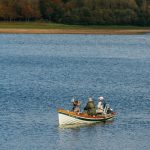Guiding and fishing in Brittany rivers and streams
Dear fly anglers, customers and lovers of Breton waters
The 2017 trout season has been an irregular one in Northern Brittany, depending on the watershed, the water levers as well as the ongoing season. A wrap-up video will be published as of now on by the end of each season.
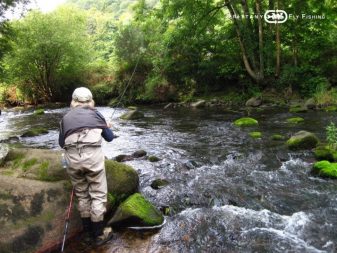
The very dry 2016/2017 winter has quite severe consequences, as low water levels were omnipresent already by spring, and for some quite early on in April, especially on the Léguer.
Low and clear waters (yet quite cold), paired with good weather were the theater of substantial hatches: Grannom sedges (Brachycentrus subnubilus) and several species of early-season ephemeroptera (Baetis rhodani, Rhithrogena semicolorata, Echdyonurus venosus) were all present.
- B. subnubilus
- E. Venosus
- R.semicolorata
- Baetis rhodani
Trout betraying their presence on the surface were scarce without ongoing hatches (besides juvenile trout and parr) so anglers were forced to resort to wets or streamer patterns. Came summer and precipitations still lacking to recharge wetlands and ground water levels, all rivers were at very low flows.
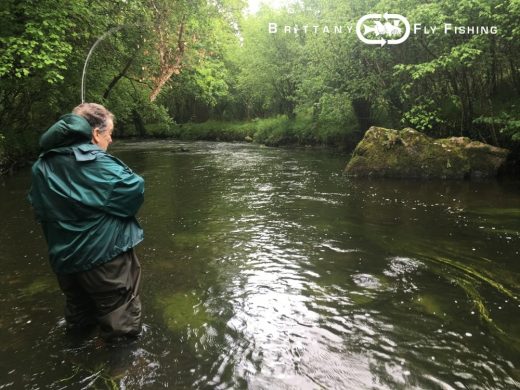
Only the Elorn, as a tailwater, was able to keep a good flow due to the waters of Drennec Lake. So it as mainly this river that was able to cope with the situation, offering decent sport all along the season. Mayfly hatches were on the timid side, however, if not disappointing, keeping the good fish from feeding on the surface, probably due to the stress of low water levels (and probably other factors as well).
The better trout were only active during cooler days, with overcast skies and a slight drizzle coming down, it’s Brittany after all. I had to resort to blind fish known fish lies to make the day of my students, but with a record number of breakoffs on fish over 16 inches.
The scenario was the same one on each occasion: directed cast to a known spot, a good fish rises while it would barely give away its presence before that, i.e. rising to natural insects, maybe a stealthy move for an emerging insect, sometimes going with a flash of movement under water.
Now pick your choice: the fish would invariably either inhale in the fly discreetly, or with an impressive sucking sound coming from the bottom of the river, a head-over tail rise in slow motion or an ultra-discreet take as if the fly had sunk into the surface film, pulled under by its own weight.
In any case, 9 times in 2017: fish grabs fly, het firmly hooked and breaks the leader after 2 to 5 seconds while on the run going upstream. Since I had anticipated the size of the players, and the risk of breaking off on the hookset, I had chosen a stronger tippet, 6X-0,125 mm over my usual 7X-0.10mm and 5X-0.15 mm when fishing Danica mayfly imitations, always quality RIO fluoroflex Plus, tippet material.
At the outcome of this, let’s call it a partial failure, the fish did rise to the flies, during the day, 100% wild brown trout of Atlantic extraction, over 16 inches, not easy by any means, the reaction of my students, beyond the emotional shock and the ensuing disappointment, was the same on every occasion: “I did not know a trout could swim so fast and pull so hard”.
On the largest fish of them all, reasonably a 18 to 20 inch fish, the line went so taut it began so sing as it went through the water. In order to find a regular activity on the surface, on the Elorn or the Aulne, anglers had to wait the hatches of Serratella ignita in June and July, going off with hatches of smaller caddisflies and some diptera, to be classified into the “micro-crap” category.
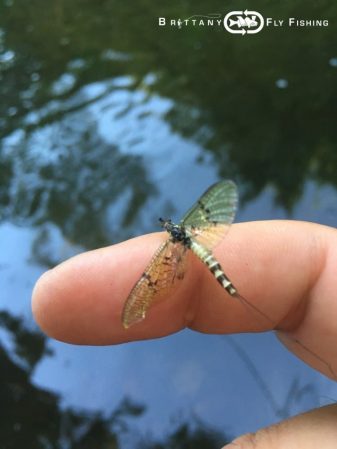
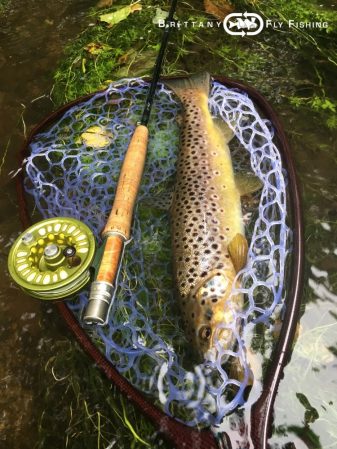
Upon my asking why they would hang on the fish so hard they felt they had to horse them in because of that felled tree… those submerged branches… or that rock… “… and I wanted to prevent him from going in there!!” Experience, nothing replaces experience, next time a big trout will take off, they will know better and lower the rod, let the fish run and keep the fingers off the reel… and start running after the fish to keep the line from breaking!
In the end, they all had learned to appreciate the moment they just had lived. Of those 9 lost fish, I assume 3 or 4 must have been sea trout, according to the way they took the fly and did take off once feeling the sting!
On the largest fish of them all, reasonably a 18 to 20 inch fish, the line went so taut it began so sing as it went through the water.
In order to find a regular activity on the surface, on the Elorn or the Aulne, anglers had to wait the hatches of Serratella ignita in June and July, going off with hatches of smaller caddisflies and some diptera, to be classified into the “micro-crap” category.
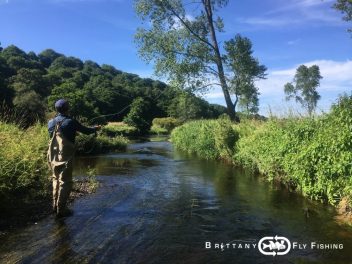
Coleoptera and other terrestrial insects were quite scarce probably because of the relative drought. Good fishing in the late hours was to be had off the beaten path in my secret haunts with impressive hatches of Yellow Sallies (Isoperla grammatica & Chloroperla torrentium) and fast-water heptagenia.
- Serratella ignita
- I. grammatica
- Echdyonurus sp.
Since water levels were so low, there has only been little fishing and guiding on the smaller coastal waters of Leon and Tregor (Penzé, rivers of Morlaix, etc.) and the Hyères in Argoat. The echoes I have received from others have justified my decision to refrain from concentrating too much on the angling there.
Fishing on the Léguer has been disappointing overall, with few hatches, fewer fish rising on the surface, low water levels, slow currents and small fish that seem to get smaller over the seasons.
Here’s a tendency that begins to scare a me a tad, it’s not much different for all those anglers that love this magnificent river the way I do. I won’t get down to the multiple reasons that could explain this decline so I hope to find one day the same great fish this river used to be famous for.
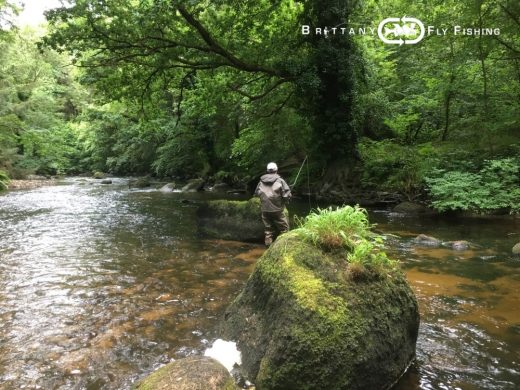
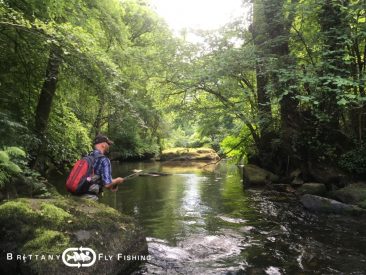
Let us hope 2018 will bring improvement as 2017 must be quickly forgotten especially the experience we had on the middle and lower reaches.
If there’s no activity on the surface, I am the first one to reach for the depths and to adapt my technique: if the fish deny my dry fly offerings, I will go below and use nymphing, and other, more secret, techniques. I was able to guide my customers to some nice fish, but my results were not overwhelming when compared to what used to be available here in Finistère, which was a lot more consistent.
With the incessant rains we get these days and the floods everywhere, we should find our rivers in a much better state the coming spring. The masses of water will certainly cleanse and regenerate the rivers and make for better insect activity, pulling along the trout to feed on them.
Nature is strong after all and all those desperate empty places during the dry summer months should harbor pretty trout once the magic of favorable conditions falls into place,
I have been able to experience this so often: the trout go into survival mode when extreme conditions prevail. Once conditions improve, they begin to thrive again. It’s definitely a result of their inherent resilience and their ability to adapt, the magic of all things wild that makes wild brown trout fishing so attractive. Come spring, I am looking forward to be able to guide my customers amidst those wild valleys and to help them open the doors to little unspoilt paradises.
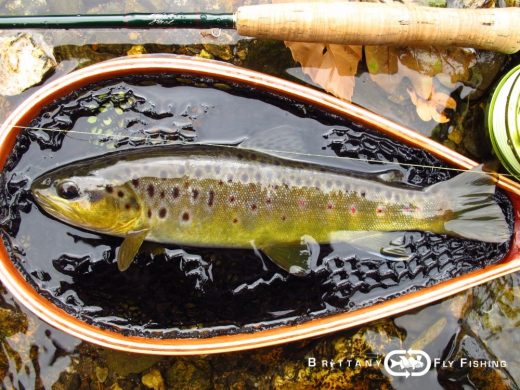
English readers can find two interesting articles about fishing and my guiding business, published in: Trout Fisherman (Elorn) & Trout & Salmon (Léguer), to be downloaded at Revue de presse page :
